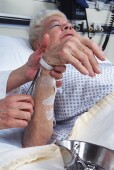
TUESDAY, Feb. 19 (HealthDay News) — Studies loaded with fraudulent data may have encouraged the use of a treatment for patients in intensive care units that now appears to do more harm than good, new research shows.
At issue is hydroxyethyl starch, an intravenous solution sometimes used to replace lost blood volume in critically ill patients. According to a new review article in the Feb. 20 issue of the Journal of the American Medical Association, the starchy solution may instead boost their risk of death or kidney failure.
“Almost certainly, what is happening is that some of the starch molecules leak out of blood vessels into the kidney itself so the kidney doesn’t work as efficiently,” said Dr. David Taylor, chairman of pulmonary and critical care medicine at Ochsner Health System in New Orleans. He was not involved in the new review.
Luckily for American patients, hydroxyethyl starch is not commonly used in the United States, Taylor said. But the new analysis serves as a cautionary tale on how fraudulent data can end up endangering patients’ lives.
As Taylor explained it, critically ill patients often develop leaky vessels, and so quickly require intravenous fluids to keep their blood pressure stable and to improve organ function.
One such fluid is simple saline or salt water, known as crystalloid solution. This is the cheapest fluid available, but it tends to leak out of blood vessels, which means it can also leak into the lungs, under the skin and into various organs.
As a result, researchers have spent considerable time and effort trying to find less leaky alternatives to saline. The protein albumin, derived from human blood, is commonly used after cardiac surgery, when the risk of fluid collecting in the lungs is high, Taylor explained. Although albumin is less leaky than saline, it is more expensive.
Hydroxyethyl starch is similar to albumin, but it contains starch molecules, which are less likely to leak out of the blood vessels than saline.
Still, many researchers had reservations about using a starch-based solution from the beginning, Taylor said.
“If you have salt water and it leaks out, you just get some salt into the tissue and it goes away with a little bit of time,” he explained. On the other hand, “if you have starch in the tissue it’s not so easy to get starch out of there, and many people were worried about the possibility of complications.”
It turns out there was even more reason to be suspicious of any alleged benefits of hydroxyethyl starch. In 2011, investigators discovered that the lion’s share of research on the treatment that was conducted by German anesthesiologist Dr. Joachim Boldt was fraudulent and had to be retracted.
So the author of the current paper wondered: Would the purported benefits of hydroxyethyl starch hold up once Boldt’s data was excluded?
Led by Dr. Ryan Zarychanski, of the University of Manitoba in Winnipeg, Canada, the team pooled data from 38 previous studies on the issue, including those by Boldt.
That analysis concluded that patients who received hydroxyethyl starch did not fare any better than other types of fluid.
But when the Boldt studies were excluded from the mix, hydroxyethyl starch was actually associated with an increased risk of death, kidney failure and need for dialysis among patients, the new research found.
It’s impossible to gauge how many patients were damaged by Boldt’s falsified research, but this new study highlights “how the inclusion or exclusion of the Boldt papers associated with research misconduct can shift the balance toward harm,” said Dr. Massimo Antonelli, author of an editorial accompanying the new study.
“It showed also how the worldwide administration of starches for volume replacement therapy have caused the increase of acute renal failure and affected mortality,” said Antonelli, a professor of intensive care and anesthesiology at the Catholic University-A.Gemelli University Hospital in Rome.
He added that a task force of the Surviving Sepsis Campaign, an organization devoted to reducing death from sepsis, recently issued guidelines warning against using starches for fluid replacement.
“These findings will reinforce [those] recommendations,” he said.
Taylor stressed, however, that it would still be helpful to find alternatives to both albumin and saline.
A person in the intensive care unit (ICU) can have 1-2 liters more of fluid going into their body than out, said Taylor. Each liter weighs 1 kilogram, or 2.2 pounds.
“It’s possible to gain anywhere from 8-10 pounds in fluid [in the ICU] so it would be a great to have an alternative to 10 pounds of weight,” he said. However, a starch solution “is not a good alternative because it increases the risk of dying or needing dialysis,” Taylor said.
More information
There’s more on critical care medicine at the U.S. National Library of Medicine.

